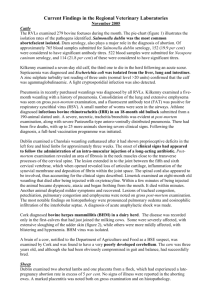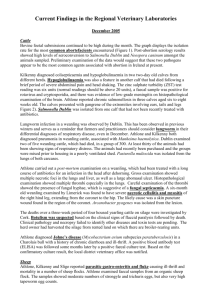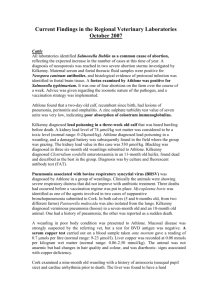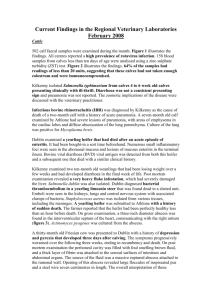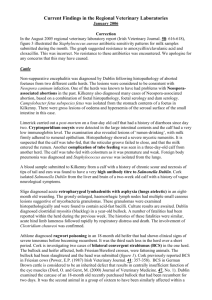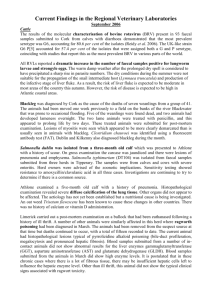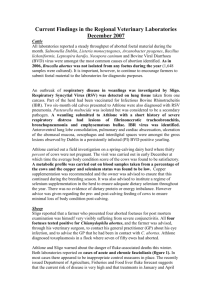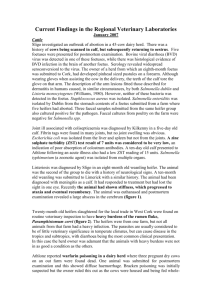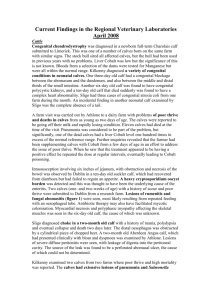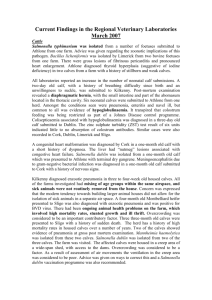September 2007
advertisement
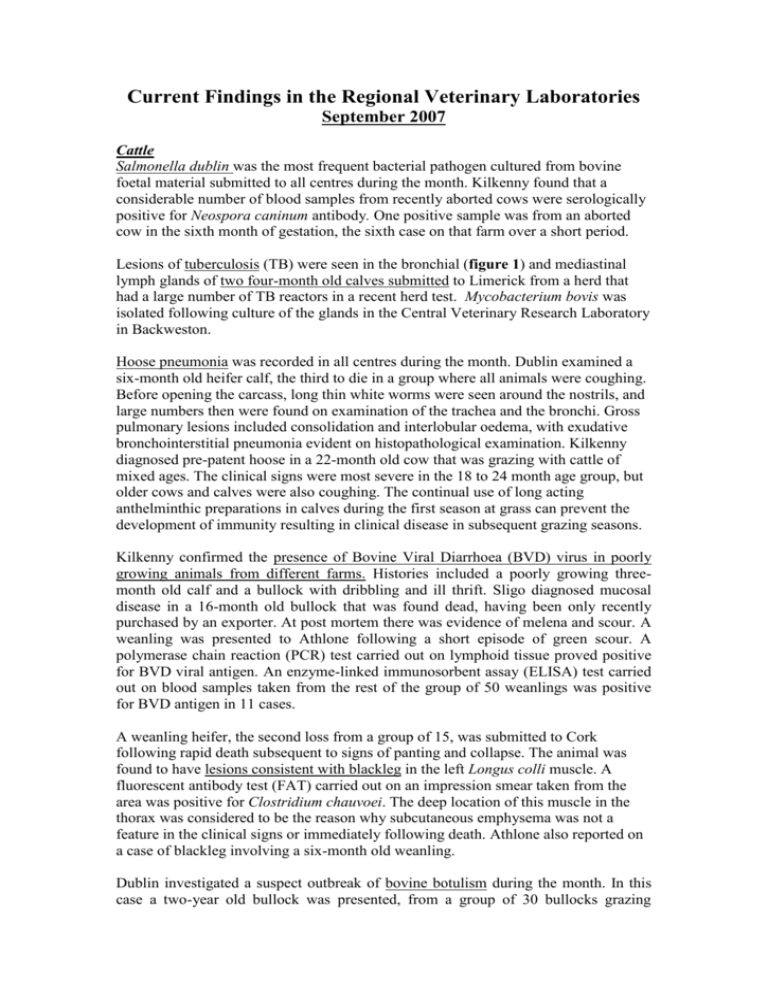
Current Findings in the Regional Veterinary Laboratories September 2007 Cattle Salmonella dublin was the most frequent bacterial pathogen cultured from bovine foetal material submitted to all centres during the month. Kilkenny found that a considerable number of blood samples from recently aborted cows were serologically positive for Neospora caninum antibody. One positive sample was from an aborted cow in the sixth month of gestation, the sixth case on that farm over a short period. Lesions of tuberculosis (TB) were seen in the bronchial (figure 1) and mediastinal lymph glands of two four-month old calves submitted to Limerick from a herd that had a large number of TB reactors in a recent herd test. Mycobacterium bovis was isolated following culture of the glands in the Central Veterinary Research Laboratory in Backweston. Hoose pneumonia was recorded in all centres during the month. Dublin examined a six-month old heifer calf, the third to die in a group where all animals were coughing. Before opening the carcass, long thin white worms were seen around the nostrils, and large numbers then were found on examination of the trachea and the bronchi. Gross pulmonary lesions included consolidation and interlobular oedema, with exudative bronchointerstitial pneumonia evident on histopathological examination. Kilkenny diagnosed pre-patent hoose in a 22-month old cow that was grazing with cattle of mixed ages. The clinical signs were most severe in the 18 to 24 month age group, but older cows and calves were also coughing. The continual use of long acting anthelminthic preparations in calves during the first season at grass can prevent the development of immunity resulting in clinical disease in subsequent grazing seasons. Kilkenny confirmed the presence of Bovine Viral Diarrhoea (BVD) virus in poorly growing animals from different farms. Histories included a poorly growing threemonth old calf and a bullock with dribbling and ill thrift. Sligo diagnosed mucosal disease in a 16-month old bullock that was found dead, having been only recently purchased by an exporter. At post mortem there was evidence of melena and scour. A weanling was presented to Athlone following a short episode of green scour. A polymerase chain reaction (PCR) test carried out on lymphoid tissue proved positive for BVD viral antigen. An enzyme-linked immunosorbent assay (ELISA) test carried out on blood samples taken from the rest of the group of 50 weanlings was positive for BVD antigen in 11 cases. A weanling heifer, the second loss from a group of 15, was submitted to Cork following rapid death subsequent to signs of panting and collapse. The animal was found to have lesions consistent with blackleg in the left Longus colli muscle. A fluorescent antibody test (FAT) carried out on an impression smear taken from the area was positive for Clostridium chauvoei. The deep location of this muscle in the thorax was considered to be the reason why subcutaneous emphysema was not a feature in the clinical signs or immediately following death. Athlone also reported on a case of blackleg involving a six-month old weanling. Dublin investigated a suspect outbreak of bovine botulism during the month. In this case a two-year old bullock was presented, from a group of 30 bullocks grazing adjacent to a heap of poultry litter. Before euthanasia at the laboratory, the bullock was in lateral recumbency and had hind limb, tail and anal paralysis. It was still able to retract the tongue and move its front legs. Samples were taken for Clostridium botulinum toxin testing and results are pending. The animal had a leucocytosis, neutrophilia and raised levels of the muscle enzyme, creatine kinase. The bullock also had evidence of ostertagiasis. Sheep Athlone visited an organic sheep farm which was experiencing large losses of lambs. It was the fourth year of a wasting and scour problem among the lambs. Adult sheep were largely unaffected. The results of tests suggested that parasitism played a major role in the problem, with high faecal egg counts recorded in all cases. The combination of a lack of dosing, the damp environmental conditions of the past summer, and the use of the same ground on a continual basis appears to have lead to the large losses. Pigs Cork examined a 13-week old pig that showed dermatitis with caudal/perineal distribution, enlarged lymph nodes (lymphadenosis), pulmonary hyperaemia, cranioventral pulmonary consolidation and enlarged kidneys with multifocal petechial haemorrhages (figure 2). Porcine dermatitis and nephropathy syndrome (PDNS) was diagnosed on the basis of gross lesions, vasculitis in different organs, multinucleated giant cells in lymph nodes and spleen and positive immunohistochemistry staining to porcine circovirus 2 (PCV2) in macrophages within some of the germinal centres of a lymph node and the spleen. Non-suppurative meningoencephalitis was diagnosed by Dublin in a sow, which presented in lateral recumbency approximately one week before farrowing. The unit had already lost the sows with a similar presentation. The inflammatory infiltrate in the brain was mainly lymphoid in nature but also contained small numbers of multinucleate giant cells, which were ZN negative. The cause of the condition was not elucidated. The sow also had severe neutrophilic and histiocytic lymphadenitis affecting lymph nodes of the head, from which Streptococcus canis was cultured. Poultry Avian vibrionic hepatitis (associated with Campylobacter jejuni) was suspected in a hen submitted to Cork that presented with an enlarged liver with randomly distributed grey pinpoint foci of necrosis that were surrounded microscopically by lymphocytic and granulocytic infiltration. Other Species Caecal impaction was found by Limerick in a four-month old foal that was found in a collapsed state, and died shortly afterwards. A very heavy parasite burden is thought to have contributed to the problem by interrupting or slowing motility. Sligo diagnosed rupture of a mediastinal abscess into the thoracic cavity as the cause of death in a Shetland pony with metastatic Streptococcus equi subspecies equi infection (Bastard Strangles). The horse had arrived in this country from the Netherlands. Two weeks later it became dull and pyrexic before dying after a short course of therapy. The most obvious lesion at post mortem was bilateral diffuse fibrino-purulent pleuropneumonia with mediastinal and bronchial lymphatic abscessation. Limerick diagnosed gastric rupture in a five-year old pregnant Irish Draught mare that was found dead. Paraquat poisoning was suspected by Sligo in a six-year old dog. The lungs were haemorrhagic and lung histopathology revealed lesions strongly suggestive of paraquat poisoning. No trace of paraquat was found on toxicology. This may be accounted for by the fact the poison had been metabolised by the time the sample was taken. Kilkenny found gross lesions of TB in a wild deer that was culled because of a high incidence of bovine tuberculosis in local cattle herds. Wild deer were frequent visitors to the farm. Gross lesions were found in the retropharyngeal and mesenteric lymph nodes. Histological findings were consistent with TB and Mycobacterium bovis was isolated. Dublin also found lesions of TB in two wild deer culled for similar reasons. CAPTIONS FOR PHOTOS Figure1 “"Lesions of TB in the bronchial lymph node of a four-month old calf – photo Alan Johnson” Figure 2 “Porcine dermatitis and nephropathy syndrome (PDNS) in a 13-week old pig- photo Pat Sheehan”
